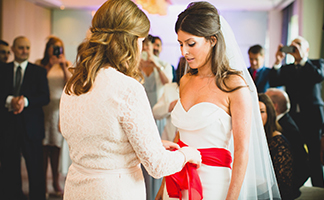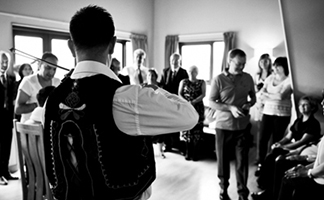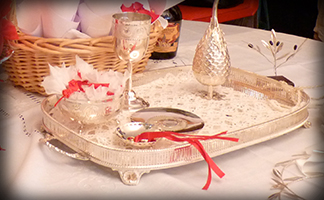The Red Scarf & Kapnistiri...

A red scarf (the Zoni) is tied around the Bride and Grooms' waist three times during the Stolisma ceremony to symbolise fertility. Traditionally it is wrapped around by the parents, close family and friends.

Traditionally, the Groom is dressed and shaved by his 'Proto Koumbaro' (Best man) which is known, very ominously, as the "last shave". Whilst the Groom is being dressed, a violinist plays and sings a traditional song to praise him before his departure from the house to the church. The Greekviolinist wears a traditional Cypriot outfit that includes a vest, called the Yeleko (or Meindani)

The Kapnistiri...
A traditional silver plated 'Kapnistiri' merecha set is used at the Greek Orthodox wedding proceedings and Stolisma.
The Kapnistiri (shaped like a teardrop) is used to bless the Bride and Groom after the Red Scarf Zomata.
The Kapnistiri can be filled with a few olive leaves that have been dried out (and usually blessed by a priest) and more often, burning charcoal and incense to give a unique aroma. It is passed around the Bride and Grooms head three times by the parents and family members in a counter-clockwise motion to bless them.
Stolisma Tradition
On the morning of a Greek Cypriot wedding, traditionally a Bride and Groom get prepared for their special day at their houses whilst close family members bless them in the form of a ceremony called a Stolisma.
Bride's Stolisma: At the Stolisma, the Bride-to-be sits in front of her family with her bridesmaids and maid of honor beside her in preparation for a blessing from her parents, close family and friends. The Bride has the traditional Red Scarf (Zoni) and Kapnistiri blessing whilst a violinist sings the traditional verses of a song. Occasionally the older family members like to join in with the singing by improvising a few verses of the song.
Groom's Stolisma: Similarly, the Groom prepares by getting dressed into his wedding outfit with help from his best man, and as the Bride, the Groom's family bless him.
Traditionally, a Stolisma atmosphere is wonderful, with violin music, and all the family together it makes the day very special indeed.
The Big Entrance...
At last, you are now married! to celebrate this opportunity and make a grand entrance at your venue, a traditional song (of your choice) can be played as you walk into the venue to be seated at the head table. In addition, a selection of songs throughout dinner can be requested.
The Traditional Dances
The Money Dance: The moment you have been waiting for...your opportunity to savor this tradition whilst your beloved family and guests pin their money onto your wedding outfits whilst you are played a live Traditional Greek Cypriot wedding dance.
Main traditional dances: Koumeres and Koumbarous (best women and best men)
can dance with their Bride and Groom. A Kalamatianos for the ladies, and a selection of songs for the gents' - the Grooms opportunity to dance with his Proto Koumbaro (best man) and all his Koumbari (best men) in turn whilst a selection of traditional
Greek songs are played.
Not forgetting the parents and close relatives...
Generally, there will be an opportunity for parents and close relatives to join in and dance traditional songs and show off their Greek dancing!
THE ABOVE ARE TYPICAL EXAMPLES OF EVENTS AT A GREEK CYPRIOT WEDDING, BUT ANY COMBINATION OF SERVICES CAN BE SELECTED TO FORM A PACKAGE TO SUIT YOUR REQUIREMENTS. PLEASE GET IN TOUCH FOR FURTHER INFORMATION.
For general enquiries please contact:
The website and its contents are subject to copyright © Greekviolinist.com 2018 - 2025

